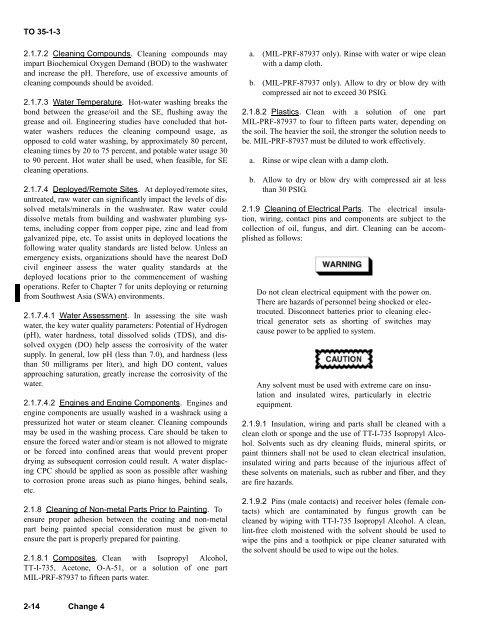TO 35-1-3 - Robins Air Force Base
TO 35-1-3 - Robins Air Force Base
TO 35-1-3 - Robins Air Force Base
You also want an ePaper? Increase the reach of your titles
YUMPU automatically turns print PDFs into web optimized ePapers that Google loves.
<strong>TO</strong> <strong>35</strong>-1-3<br />
2.1.7.2 Cleaning Compounds. Cleaning compounds may<br />
impart Biochemical Oxygen Demand (BOD) to the washwater<br />
and increase the pH. Therefore, use of excessive amounts of<br />
cleaning compounds should be avoided.<br />
2.1.7.3 Water Temperature. Hot-water washing breaks the<br />
bond between the grease/oil and the SE, flushing away the<br />
grease and oil. Engineering studies have concluded that hotwater<br />
washers reduces the cleaning compound usage, as<br />
opposed to cold water washing, by approximately 80 percent,<br />
cleaning times by 20 to 75 percent, and potable water usage 30<br />
to 90 percent. Hot water shall be used, when feasible, for SE<br />
cleaning operations.<br />
2.1.7.4 Deployed/Remote Sites. At deployed/remote sites,<br />
untreated, raw water can significantly impact the levels of dissolved<br />
metals/minerals in the washwater. Raw water could<br />
dissolve metals from building and washwater plumbing systems,<br />
including copper from copper pipe, zinc and lead from<br />
galvanized pipe, etc. To assist units in deployed locations the<br />
following water quality standards are listed below. Unless an<br />
emergency exists, organizations should have the nearest DoD<br />
civil engineer assess the water quality standards at the<br />
deployed locations prior to the commencement of washing<br />
operations. Refer to Chapter 7 for units deploying or returning<br />
from Southwest Asia (SWA) environments.<br />
2.1.7.4.1 Water Assessment. In assessing the site wash<br />
water, the key water quality parameters: Potential of Hydrogen<br />
(pH), water hardness, total dissolved solids (TDS), and dissolved<br />
oxygen (DO) help assess the corrosivity of the water<br />
supply. In general, low pH (less than 7.0), and hardness (less<br />
than 50 milligrams per liter), and high DO content, values<br />
approaching saturation, greatly increase the corrosivity of the<br />
water.<br />
2.1.7.4.2 Engines and Engine Components. Engines and<br />
engine components are usually washed in a washrack using a<br />
pressurized hot water or steam cleaner. Cleaning compounds<br />
may be used in the washing process. Care should be taken to<br />
ensure the forced water and/or steam is not allowed to migrate<br />
or be forced into confined areas that would prevent proper<br />
drying as subsequent corrosion could result. A water displacing<br />
CPC should be applied as soon as possible after washing<br />
to corrosion prone areas such as piano hinges, behind seals,<br />
etc.<br />
2.1.8 Cleaning of Non-metal Parts Prior to Painting. To<br />
ensure proper adhesion between the coating and non-metal<br />
part being painted special consideration must be given to<br />
ensure the part is properly prepared for painting.<br />
2.1.8.1 Composites. Clean with Isopropyl Alcohol,<br />
TT-I-7<strong>35</strong>, Acetone, O-A-51, or a solution of one part<br />
MIL-PRF-87937 to fifteen parts water.<br />
a. (MIL-PRF-87937 only). Rinse with water or wipe clean<br />
with a damp cloth.<br />
b. (MIL-PRF-87937 only). Allow to dry or blow dry with<br />
compressed air not to exceed 30 PSIG.<br />
2.1.8.2 Plastics. Clean with a solution of one part<br />
MIL-PRF-87937 to four to fifteen parts water, depending on<br />
the soil. The heavier the soil, the stronger the solution needs to<br />
be. MIL-PRF-87937 must be diluted to work effectively.<br />
a. Rinse or wipe clean with a damp cloth.<br />
b. Allow to dry or blow dry with compressed air at less<br />
than 30 PSIG.<br />
2.1.9 Cleaning of Electrical Parts. The electrical insulation,<br />
wiring, contact pins and components are subject to the<br />
collection of oil, fungus, and dirt. Cleaning can be accomplished<br />
as follows:<br />
Do not clean electrical equipment with the power on.<br />
There are hazards of personnel being shocked or electrocuted.<br />
Disconnect batteries prior to cleaning electrical<br />
generator sets as shorting of switches may<br />
cause power to be applied to system.<br />
Any solvent must be used with extreme care on insulation<br />
and insulated wires, particularly in electric<br />
equipment.<br />
2.1.9.1 Insulation, wiring and parts shall be cleaned with a<br />
clean cloth or sponge and the use of TT-I-7<strong>35</strong> Isopropyl Alcohol.<br />
Solvents such as dry cleaning fluids, mineral spirits, or<br />
paint thinners shall not be used to clean electrical insulation,<br />
insulated wiring and parts because of the injurious affect of<br />
these solvents on materials, such as rubber and fiber, and they<br />
are fire hazards.<br />
2.1.9.2 Pins (male contacts) and receiver holes (female contacts)<br />
which are contaminated by fungus growth can be<br />
cleaned by wiping with TT-I-7<strong>35</strong> Isopropyl Alcohol. A clean,<br />
lint-free cloth moistened with the solvent should be used to<br />
wipe the pins and a toothpick or pipe cleaner saturated with<br />
the solvent should be used to wipe out the holes.<br />
2-14 Change 4
















